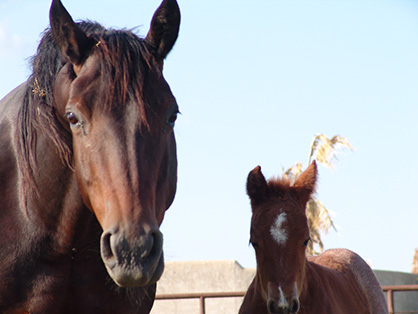New Way to Monitor Body Fat in Horses, BMI For Humans, BCI For Horses!
 Obesity in horses and ponies is a big problem but thanks to a new study, conducted by the University of Melbourne, Australia, in collaboration with the WALTHAM® Equine Studies Group, there could now be a more effective practical way to monitor body fat and weight loss.1 A new Body Condition Index (BCI) has been devised that works in a similar way to the body mass index (BMI) used in humans. It should enhance the value of Body Condition Scoring (BCS), which remains an important routine tool for general weight monitoring. The work will be presented at the Equine Science Society (ESS) in Florida in May 2015.
Obesity in horses and ponies is a big problem but thanks to a new study, conducted by the University of Melbourne, Australia, in collaboration with the WALTHAM® Equine Studies Group, there could now be a more effective practical way to monitor body fat and weight loss.1 A new Body Condition Index (BCI) has been devised that works in a similar way to the body mass index (BMI) used in humans. It should enhance the value of Body Condition Scoring (BCS), which remains an important routine tool for general weight monitoring. The work will be presented at the Equine Science Society (ESS) in Florida in May 2015.
In last year’s National Equine Health Survey (NEHS) overweight horses or ponies were recorded in 16.9% of cases, which was more than double the previous year’s figure of 7.8%.* In our own study of predominantly outdoor living horses and ponies we found an even higher prevalence of obesity: nearly 30% coming out of the winter and around 35% in the summer.2 Obesity presents many health risks including the Equine Metabolic Syndrome and an increased risk of laminitis. The NEHS also showed that only 59% of respondents assess their horse’s weight regularly, using weigh tapes and body condition scoring.
Accurate assessment of fat deposits can help to identify levels of obesity and enable monitoring of weight loss. While body condition scoring is reasonably accurate and is a valuable way of keeping track of weight on a routine basis, especially when carried out by experienced investigators, it is subjective and therefore potentially less accurate for many owners or inexperienced assessors.
The aim of the study was to develop a body condition index (BCI), similar to the body mass index (BMI) used in humans, based on objective body measurements that correlated well with actual body fat percentage. The study involved 22 adult horses and ponies of mixed breeding with body condition scores ranging from 4 to 8.5 out of 9. Body fat percentage was accurately determined using a proven scientific method and an objective body condition index was derived based on repeated measurements of heart girth, belly girth, body length, neck circumference and height to the withers. Body condition scoring (by experienced investigators) correlated reasonably well with body fat and the new objective BCI also gave a similar good correlation.
The new Body Condition Index is designed to complement regular Body Condition Scoring. It provides a step up in terms of objective weight monitoring, specifically in the early stages of a weight loss program when we have previously shown a BCS may not change, most likely because the horse or pony is initially losing internal fat, which does not show on the outside.3 With longer-term use the new BCI may also help owners to check their accuracy of body condition scoring and become more confident and efficient with it.
To date, the WALTHAM® Equine Studies Group, which provides the science behind the SPILLERS® brand, has conducted more than 20 research projects over the past 10 years, looking at all aspects of laminitis including investigating the role that obesity can play in the development of the condition. This work not only aims to build knowledge but also to give practical support to owners of susceptible animals.
Clare Barfoot, Registered Nutritionist at SPILLERS® said: “The new index is a very promising tool for a more objective estimation of body fat % in the field. It could be especially useful if horses and ponies are assessed by more than one person, particularly if they are not experienced at body condition scoring. A more accurate way of monitoring fat, used in conjunction with body condition scoring, should make it easier for owners to manage weight loss programmes more effectively and this means healthier horses!”
For more information on how to manage your horse’s weight visit www.spillers-feeds.com or call the SPILLERS® Care-Line on + 44 (0)1908 226626.
References
1Derivation of a new body condition index to estimate body fat percentage from morphometric measurements: comparison with body condition score, Samantha Potter, Faculty of Veterinary Science, The University of Melbourne, Victoria, Australia, Pat Harris, WALTHAM Equine Studies Group, WALTHAM Centre for Pet Nutrition, Leicestershire, UK, & Simon Bailey, Faculty of Veterinary Science, The University of Melbourne, Victoria, Australia, to be presented at the Equine Science Symposium May 2015 Florida
2Giles SL, Rands SA, Nicol CJ & Harris PA (2014). Obesity prevalence and associated risk factors in outdoor living domestic horses and ponies. PeerJ 2: e299
3Dugdale A,. CurtisGC, Cripps P. HARRIS P., & Argo CMcG (2010) Effect of dietary restriction on body condition, composition and welfare of overweight and obese pony mares. Equine Veterinary Journal 42 (7) 600 – 610
*The National Equine Health Survey, conducted by the Blue Cross, was completed by 3,669 horse UK owners in May 2014. The survey contained 25 questions on general horse health, care and management and was validated by Professor Josh Slater of the Royal Veterinary College.










